 HOME
HOME
Caries, or decay, is always bad news for a tooth. Tooth decay is the softening of your tooth enamel and refers to the damage tooth structure caused by acids that are created when plaque bacteria break down sugar in your mouth. If this loss of mineral from the enamel is left untreated, a cavity, or hole in the tooth, can eventually occur. Without treatment, these holes can grow larger over time and may even destroy the whole tooth.
The plaque acids then eat away at the next layer of the tooth (dentin), and this is when you usually start getting pain, as the dentin is close to the nerve of the tooth. Hot and cold food and drink will then aggravate the nerve, which causes pain.
But hidden caries is possibly worse than having a normal cavity. We can quite easily see a normal cavity, as it has a distinct appearance, and our dental probe will get stuck in the decayed enamel. Below is a picture of a normal cavity and subsequent filling. The first picture shows the decay in situ; there are darker areas in the fissures, and there is a white, sticky residue where the enamel has broken down. The second picture is where we have entered the tooth to remove the decay, and you can see the dark decayed areas are now into the second layer of the tooth, the dentin. The third picture shows how we’ve removed all the decayed material, leaving all the lovely, healthy tooth in place. The final picture shows the filling that we have put back into the tooth. Much better!
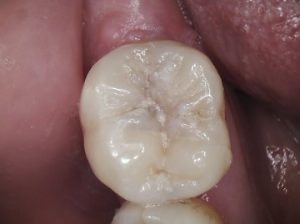

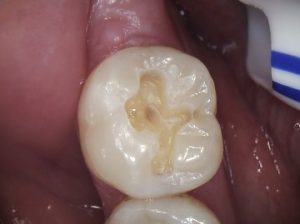
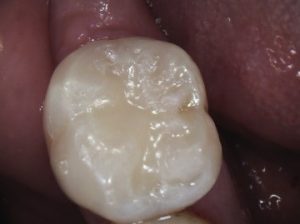
Hidden caries, however, is exactly that; hidden. The decay will be near the surface of the tooth but will have caused little or no damage to the enamel surface itself. But sometimes, there may also only be a small indication of a problem on the surface of the tooth, such as a brown mark or the enamel may appear cloudy.
Caries can also be hidden in the way that we can see that there is caries in the tooth, but there may be much more than we initially thought, and the decay may go further into the tooth than we anticipated. It may look like a small filling, but the tooth may end up needing a large filling because of the amount of decay.
The only way we can really find hidden caries is with an x-ray, and this is why we take them routinely every 2 years to check for hidden issues like this. Obviously, we also check bone levels, existing restorations and the general health of your mouth as well with these x-rays.

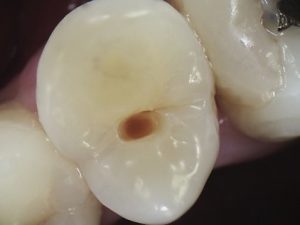

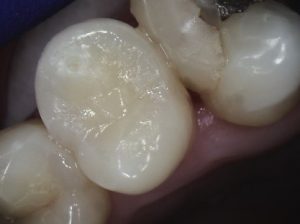
If you would like to know more about our white fillings, please click here.
If you have any questions or would like to make an appointment, please do not hesitate to call us on 0121 550 6958.
Back to Blog| Cookie | Duration | Description |
|---|---|---|
| cookielawinfo-checkbox-advertisement | 1 Year | The cookie is set by GDPR cookie consent to record the user consent for the cookies in the category "Advertisement". |
| cookielawinfo-checkbox-analytics | 11 months | This cookie is set by GDPR Cookie Consent plugin. The cookie is used to store the user consent for the cookies in the category "Analytics". |
| cookielawinfo-checkbox-necessary | 11 months | This cookie is set by GDPR Cookie Consent plugin. The cookies is used to store the user consent for the cookies in the category "Necessary". |
| cookielawinfo-checkbox-other | 1 year | Set by the GDPR Cookie Consent plugin, this cookie is used to record the user consent for the cookies in the "Other" category . |
| viewed_cookie_policy | 11 months | The cookie is set by the GDPR Cookie Consent plugin and is used to store whether or not user has consented to the use of cookies. It does not store any personal data. |
| Cookie | Duration | Description |
|---|---|---|
| _ga | 2 Years | This cookie is installed by Google Analytics. The cookie is used to calculate visitor, session, campaign data and keep track of site usage for the site's analytics report. The cookies store information anonymously and assign a randomly generated number to identify unique visitors. |
| _gat_gtag_UA_135273458_1 | 1 Minute | This cookie is set by Google and is used to distinguish users. |
| _gid | 1 Day | This cookie is installed by Google Analytics. The cookie is used to store information of how visitors use a website and helps in creating an analytics report of how the website is doing. The data collected including the number visitors, the source where they have come from, and the pages visted in an anonymous form. |
| vuid | 2 years | Vimeo installs this cookie to collect tracking information by setting a unique ID to embed videos to the website. |
| Cookie | Duration | Description |
|---|---|---|
| _fbp | 3 months | This cookie is set by Facebook to deliver advertisement when they are on Facebook or a digital platform powered by Facebook advertising after visiting this website. |